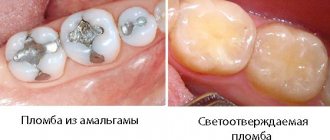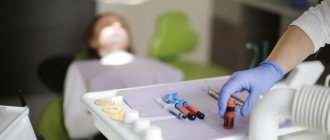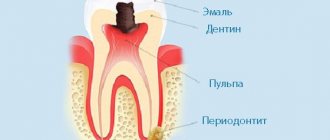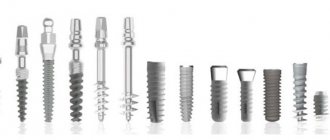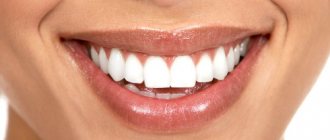- Why a temporary filling is placed: types of material
- Why does a tooth with a temporary filling hurt: the main reasons
- Standard activities after installation of the material
- Temporary filling hurts when pressed: how to cope with the disease
Many patients complain to dentists that their tooth hurts under a temporary filling. For the first 2-3 days, a slight aching pain is considered normal and does not cause cause for concern or panic. It is associated with the active influence of drugs on the nerve endings of the molar or premolar.
If the temporary filling hurts very strongly and for a long time when pressed, it is recommended to make an appointment with a specialist earlier than the specified date. Dentists at the reliable A-Medic clinic will conduct a thorough examination and prescribe a diagnostic examination to find out what exactly is causing the pain. All people are scared that they have had a temporary filling installed and their tooth hurts, but most often there is no reason to worry.
If your tooth hurts after filling
So, why does a tooth hurt after filling? Any installation of a filling is an intervention in the tissue, so pain during and after treatment may well occur. On the other hand, one pain is a natural stage in the recovery of the body after treatment, and the other is a sign of incipient complications or injury. So when should you sound the alarm? Experts distinguish different types of toothache: according to duration, nature of manifestation and correlation with various types of manipulations.
Indications for use of arsenic paste
Arsenic paste is used in cases where, for one reason or another, other painkillers cannot be used. The main purpose of its use is the destruction of the neurovascular bundle. Among the secondary indications, the following should be noted:
- Inability to use alternative analgesic drugs due to the patient's health condition. We are talking about those cases when the patient has arterial hypertension or the day before a large dose of alcohol was consumed.
- Urgent medical care when no other pain relief options are available.
- Allergic reaction to the composition of similar drugs.
- Ineffective pain relief for a damaged tooth with other medications due to the patient’s high pain threshold.
Arsenic paste is also used in pediatric dentistry. The thing is that with baby teeth you can’t give local anesthesia with injections.
Classic filling
The conventional filling procedure does not imply penetration into the tooth pulp and depulpation of the root canals. This manipulation is much simpler compared to endodontic intervention, however, not everything is so obvious here. First, conventional therapeutic procedures are performed more frequently. Secondly, the quality of materials and the level of specialists in Russia are often low, so severe pain after filling a tooth and other complications are by no means uncommon even with the simplest manipulations. Below is a table that describes the most common causes of complications and pain after filling.
| Type of complication | Description | Pain symptoms |
| Mechanical trauma to the pulp during filling (pulp perforation) | It occurs when the bur is used roughly and carelessly, when the partition between the pulp and dentin is destroyed. Modern dentistry offers conservative ways to eliminate such complications, but often only a depulpation procedure can help. | With this problem, the tooth “pulsates” after filling and reacts sharply to cold and hot. The pain is severe and practically does not subside. |
| Burn of dentin or pulp (tooth overheating) | Usually occurs when the cooling system of the drill malfunctions, when the tooth tissue gets burned during the operation of the drill. In the most severe cases, the patient develops pulpitis and periodontitis. | If your tooth ache after filling and the pain does not go away for a long time, it is quite possible that you have a dentin burn. If, after filling, the tooth reacts sharply to hot and cold or there is throbbing pain, then most likely the pulp was affected. |
| Incorrectly installed seal | Overbite and overhanging filling edges are among the most common causes of pain. Incorrect closure of the dentition provokes very unpleasant sensations. | Does your tooth hurt when you bite it after filling? Perhaps the problem is an incorrectly installed seal. If the cause is not eliminated in time, the tooth reacts painfully even with gentle pressure. |
| Error when choosing material | There are more than a dozen filling materials on the market, many of which are not suitable for everyone due to their properties and components. | Acrylic composite and silicate cement fillings can cause allergies and inflammation. Amalgams and some light fillings can shrink, which is why the tooth hurts quite noticeably when bitten after filling. |
| Gum injuries | Damage to soft tissue is a very common occurrence during therapeutic manipulations (especially in the treatment of cervical caries). Serious injuries may require gum grafting. | Aching or cutting pain at the site of gum damage. |
The dangers of arsenic paste
In modern dentistry, arsenic paste is used exclusively for indications. If the dosage is violated, the recommendations of specialists or in the case of individual characteristics of the body, its toxic properties may appear. In addition, the following complications may occur:
- swelling of the pulp;
- development of progressive periodontitis;
- darkening of dentin;
- necrotization of the periosteum;
- intoxication of internal organs.
Experts do not recommend using arsenic paste when treating pregnant women. It is also used with caution in pediatric dentistry. For these categories of patients, other, newer options for treating pulpitis are used.
If your tooth hurts after root canal filling
Unlike classic filling, root canal treatment is a procedure that essentially kills the tooth and its tissues. Of course, after such manipulations, pain in the first few days is quite common (this is related to the question of whether a tooth should hurt after root canal filling). However, if a tooth hurts a week after filling, then this is a good enough reason to start worrying. Pain after root canal filling can be caused by a number of reasons, but in any case you should not think that everything will go away on its own. Negligence in relation to one's own health can lead to periodontitis, damage to bone tissue and even death caused by infection of the body. So, in popular parlance, when your nerve hurts after filling a tooth, you have serious cause for concern.
Arsenic anesthesia procedure
The anesthesia procedure using arsenic is carried out in several stages:
- First, the dentist opens the pulp and removes damaged dentin tissue. At this stage, local anesthesia is used.
- A paste containing arsenic is placed into the open channel. The dosage is calculated individually, taking into account the clinical picture of the pathological process. It is covered with Phenol or Camphor on top.
- At the next stage, the dentist places a temporary filling. It will keep the paste from falling out during chewing and salivation.
- Under the influence of the paste, the neurovascular bundle begins to gradually die. This process may be accompanied by pain that lasts several hours or even days.
- A few days later, at a follow-up appointment, the doctor resects the dead nerve, cleans the dental canals and refills them.
At the preliminary consultation, the doctor should tell the patient about the upcoming procedures. He also warns of possible restrictions while arsenic is in the tooth. Gives recommendations regarding complications.
Why does a tooth hurt after root canal filling?
| Type of complication | Description | Pain symptoms |
| Root perforation | As a rule, this happens when installing a pin into root canals, when its tip breaks through the root walls and rests on the bone tissue. The patient requires quite complex rehabilitation, otherwise there is a high probability of developing an infection. | Severe aching pain that can extend beyond the tooth. |
| Underfilling | A cavity remains in the root canals, which is not filled with filling material. This can lead to inflammation and abscesses. | A slight aching pain in the early stages and a strong (sometimes throbbing) pain as complications develop. Often after filling a tooth, the gums hurt. |
| Resealing | The material is planted too deep beyond the root tip. If its amount is insignificant, then over time it can resolve on its own. In more serious situations, resection of the root apex is required. | Prolonged aching pain up to neuralgia. |
| Fragments of tools in channels | A common medical mistake is when a piece of instrument remains inside the root canals. | From aching to sharp piercing pain when biting. If, after canal filling, it hurts to press on a tooth, this may also be one of the characteristic signs. |
When, after removing the nerve and filling, the tooth hurts during the first two to three days and the pain is pronounced, tell your dentist about it. In some cases, a quick response to the problem will help avoid serious complications.
Removing a temporary filling
After the filling is installed, the patient has a question: “How long can you walk with a temporary filling?” Only a qualified specialist can determine the optimal time to wear it.
The second visit to the dentist should include:
- Removal of temporary filling and medication.
- Rinsing the cavity with an antiseptic solution and drying.
- Filling the canals with pins (rods that replace the filling of the canals and strengthen damaged teeth) and sealer (cement that fills the gap between the pins and the walls of the canal).
- Checking the correctness of the filling using an x-ray.
- Reinstallation of the filling. Necessary for pulpitis.
- Installation of a permanent filling.
If the image shows that the canals are not completely sealed or the pins extend beyond the root, then the tooth will have to be refilled.
Tooth pain after filling in questions and answers
Question: Can a tooth hurt after filling?
Answer:
Yes, especially after depulpation. This is not always a sign of complications, but it is worth seeing a doctor.
Question: What to do after filling a tooth?
Answer:
Follow the doctor’s recommendations and do not subject the treated tooth to heavy loads in the first days.
Question: How long does a tooth hurt after filling (classic)?
Answer:
If your tooth hurts severely for more than a day or two after getting a filling, tell your dentist as soon as possible.
Question: How long does a tooth hurt after root canal filling?
Answer:
In the absence of complications, a period of one to three days is considered normal (excluding severe throbbing pain). If your tooth hurts a week after filling (even if the pain is not too severe), be sure to consult a doctor.
Question: Is it normal to have tooth sensitivity after filling?
Answer:
After therapeutic manipulations, the sensitivity of the tooth may increase, but if after filling the tooth reacts to cold and hot with excessive pain, consult a doctor.
Question: How much can you not eat after filling a tooth with a light filling?
Answer:
It is not recommended to eat food within 1–2 hours.
Question: Why does a tooth hurt after filling when pressed?
Answer:
If there are complications in the form of inflammation and damage to tooth tissue, any mechanical impact will not cause the most pleasant sensations.
Question: What should I do if the tooth is swollen after filling?
Types depending on material
A temporary filling is made of plastic, water-insoluble materials. They are selected taking into account the condition of the diseased tooth and the purpose of installation.
- Dentine paste. Protects teeth from staining with amalgams and has water-repellent properties. Not for use with liquid medications. Hardening time – 2 hours. Service life – 7-10 days.
- Vinoxol. It has high strength and can maintain integrity for up to six months. Thanks to its antiseptic properties, it disinfects the tooth cavity. Hardening time – up to 4 hours.
- Artificial dentin. Zinc sulfate cement is installed for up to 3 days. Before installation, the tooth must be thoroughly dried, because it does not harden in a humid environment.
- Nice. May be pink and white. White teeth are most often filled with non-pulpless teeth. Pink filling compound is suitable for covering arsenic or cotton swab. Does not cause irritation.
- Polycarboxylate cement. It has high strength and biocompatibility. Used for filling permanent and baby teeth, fixing dentures.
- A mixture of zinc oxide and eugenol. It has a sedative effect and disinfects the cavity well. Resistant to chewing loads. Hardens within 12 hours.
Diagnosis of pain when pressing on the dental nerve
Determination of the pathology caused by the installation of a temporary filling occurs through a visual examination using dental instruments. In most cases, pain is caused by a broken seal or improper installation. Similar signs can be seen visually. If the patient complains of pain, but there are no external signs, the hole is opened. Then the tooth socket, its canals and nearby tissues are examined.
In rare cases, an allergen sample is taken if the cause of the pain cannot be identified.
Prevention of childhood pulpitis
Treating pulpitis in baby teeth is difficult and expensive, so it is best to avoid it. The following preventive measures will help with this:
- Start oral hygiene from the eruption of the very first tooth, and gradually accustom the child to it.
- Brush children's teeth with special toothpastes containing age-appropriate fluoride.
- Avoid giving your child too many sweets, especially sugary drinks. The most dangerous thing is to give a child sweets from a bottle - because of this, the front teeth are often affected by caries, and then pulpitis.
- Make sure your child's diet includes plenty of fresh vegetables and fruits. Solid foods are especially beneficial - they strengthen teeth and help remove plaque.
- Every six months, take your child to the dentist for preventive examinations so that the doctor can notice and treat caries in time.
- At the first signs of even mild dental damage, do not let the process take its course, but take the child to the dentist.
These measures will help you prevent pulpitis and keep your child's baby and permanent teeth healthy.

